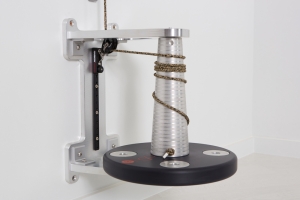RSP ISQUIO
Eccentric Hamstring Training with RSP Isquio
ABOUT RSP ISQUIO
Rsp Isquio is another step in RSP to offer you specific tools that provide the solution to one of the most common muscle injuries in sports.
Isquio is born to prevent injuries to the hamstring muscles by reproducing the same range of load generated by the athlete when running at high speed. The objective of this machine is to generate high accelerations of the leg that in the eccentric phase will have to brake in a coordinated and stable way with the great particularity that Isquio offers the maximum tension to the athlete (moment in which the rope is wound in the minimum radius of the axis) when the maximum extension of the knee is beeing reached. This increasing load that we generate by reducing the radius as we extend the knee and apply strength to stop the leg from moving, is intended to reproduce and work on the two most important factors of hamstring injuries. On the one hand to be able to train the stabilization of the hip avoiding its hyperextension in the final phase of the extended knee before reaching the floor and on the other hand improving the strenght of the flexor and extensor muscles of the knee and hip increasing the dynamic performance of the sportsman.
This machine is very different to a traditional conical pulley in order to offer the opposite behaviour to that of a traditional machine by offering the maximum resistance in the eccentric-concentric transition (end of the braking phase and beginning of the recovery phase)
The small difference between the minimum and maximum radius is due to the fact that this machine works in reverse, as if we wanted to reduce gears in our car and therefore the variation of the radius must be small, otherwise the movement becomes very complex to execute and it is easy to lose control in the concentric/eccentric transition (as if our car skidded)
How to adjust the RSP ISQUIO
The conical pulleys have two types of load settings that will vary machine´s response to the athlete´s application of force:
-Varying the moment of inertia: the moment of inertia is defined as the minimum value of force that the athlete has to apply to vary the machine´s state of rest, this means that the higher this value is, the more force the athlete has to apply to start and stop the machine, and the more time he will need to stop the machine and start it again (slower the Eccentric/Concentric transition)
– Varying the axis radius: the conical axis in an inertial machine has the same objective as the gearbox of our car, to facilitate the ability to accelerate with the same application of force. As we raise the position of the rail and reduce the radius of the axis, we reduce the capacity to accelerate the machine, making the movement slower and this allows us to increase the time of tension during the excercise
To find out more about this, see our article
How to use for eccentric hamstring training
With this machine you will be able to perform all the movements related to to the flexo-extension of the knee and hip, being able to establish progressions both in the complexity of the application of force, as in the need to stabilize ourselves to apply that force. We can workout both ways by standing or lying down, and we can incorporate supports to increase our balance with a balance hurdle or a pica.
The most important thing to carry out this exercise well is to adjust the length of the rope in relation to our position , in this case given the increasing load as the leg extends and therefor complicates the position to the apply the force, we recommend making the change of direction of the leg before feeling the limit of the rope to avoid this sudden impact to destabilize us.
We must look for the right angle and hip position on the ground to reproduce the gesture simulating the sprint position of the athlete, in this way we will achieve the greatest protective and performance effect.
TECHNICAL SPECIFICATIONS
| Size: | 45 x 35 x 45 cm high. |
| Weight: | 15 kg. |
| Accessories: | – RSP Encoder – Stainless steel masses – High load pulleys (high performance at high working densities) – Adaptor Chronojump encoder – Portability kit (to fix the machine to a solid structure such as goal, trellis, column..) |
| Adaptations: | Customization for specific jobs |
| Spare parts: | – Wall rail pulley – Chassis pulley – Rope (4 meters) |
| See spare parts and accessories: |
Moments of inertia
| Without masses: | 589,84 Kg/cm2 |
| 2 masses: | 704,99 kg/cm2 |
| 4 masses: | 820,13 Kg/cm2 |
STANDARD EQUIPMENT
– Chassis RSP Isquio
– 120cm wall rail for height adjustment of the output pulley
– 4 aluminium masses
– 40mm Ø Harken Carbo pulley
– 40mm Ø T2 Loop Harken Carbo pulley
– 4 meters of high performance rope with length adapter
– Ankle string
– Wall mounting kit
– Assembly manual



